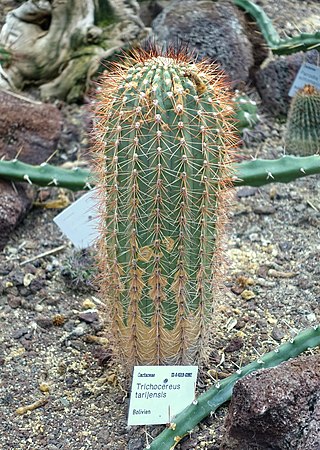
Pilosocereus is a genus of cactus native to the Neotropics. Tree cactus is a common name for Pilosocereus species. The genera Caerulocereus and Pseudopilocereus are synonyms of this genus.

Cipocereus bradei is a species of cactus. It is endemic to the state of Minas Gerais in Brazil. It is threatened by habitat loss.

Lobivia backebergii is a species of flowering plant in the cactus family Cactaceae, native to eastern Bolivia and southern Peru.

Soehrensia thelegona is a species of cactus in the Soehrensia genus.

Armatocereus matucanensis is a species of Armatocereus from Ecuador and Peru.

Gymnocalycium ochoterenae is a species of Gymnocalycium from Argentina.

Echinopsis densispina, is a species of Echinopsis found in Argentina.

Soehrensia tarijensis, is a species of Soehrensia, in the cactus family. It is native to Bolivia and northwestern Argentina.

Cereus pierre-braunianus is a species of columnar cactus found in NE Goiás in Brazil.

Pilosocereus albisummus is a species of Pilosocereus found in Minas Gerais, Brazil.

Weberbauerocereus cephalomacrostibas is a species of cactus in the family Cactaceae. It is found in Arequipa Department, Peru and consists of 2 subpopulations.

Xiquexique is genus of cactus from Brazil.

Xiquexique gounellei is a species of plant in the genus Xiquexique of the cactus family. Common names include "Alastrado", "Chique-Chique", "Xique-Xique" and "Xique-Xique das Pedras".

Leucostele deserticola is a species of cactus native to South America.

Cephalocereus columna-trajani is a species of cactus from Mexico.

Cephalocereus euphorbioides is a species of Cephalocereus from Mexico.

Cephalocereus mezcalaensis is a species of Cephalocereus from Mexico.

Pilosocereus auristetus is a species of cactus native to Minas Gerais, Brazil and was first described in 1957.
Leucostele tunariensis is a species of columnar cactus native to South America.

Echinocereus viereckii is a species of cactus native to Mexico.



















